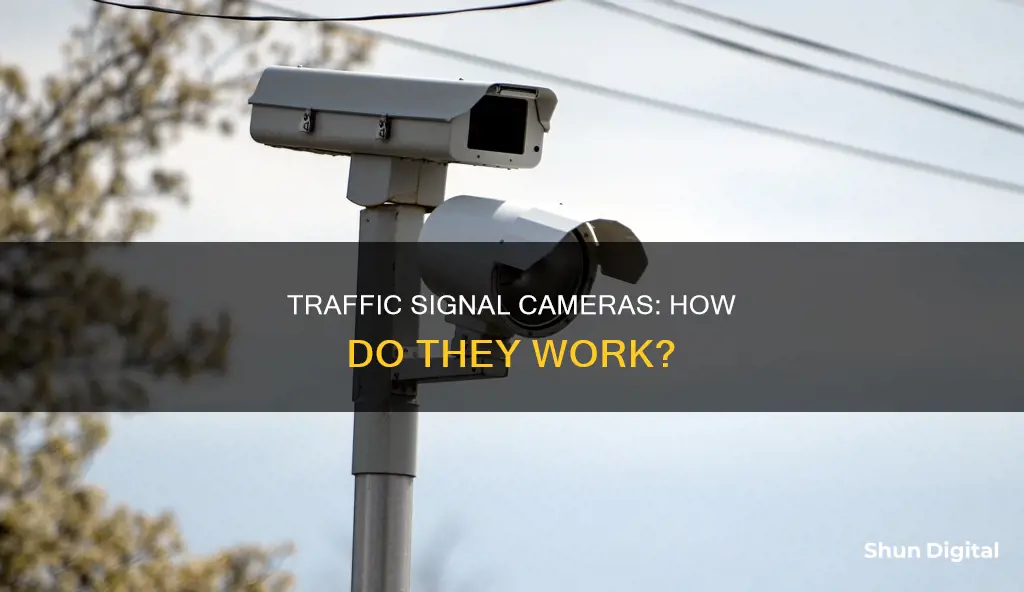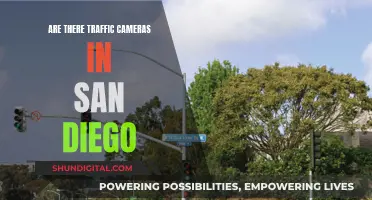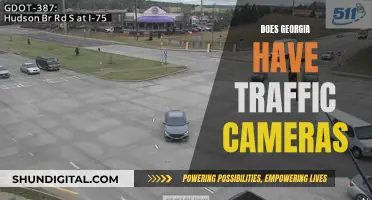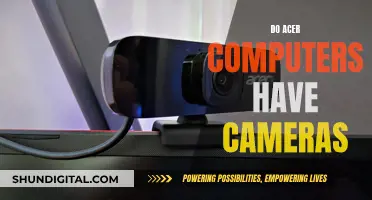
Traffic signal cameras, also known as 'red-light cameras', are motion-activated camera devices installed at traffic lights on major junctions to capture vehicles that pass through a red light. They are designed to deter speeding and dangerous driving, and to ensure motorists obey driving laws. These cameras are usually placed on tall metal poles before or after the traffic light or mounted on street light poles. They are often large, square boxes in silver, yellow or white colour.
| Characteristics | Values |
|---|---|
| Purpose | To keep roads safe |
| Installation | Installed at traffic lights on major junctions, busy intersections, and accident hotspots |
| Function | Detect and photograph vehicles that pass through a red light |
| Activation | Motion-activated; become active when the traffic light turns red |
| Grace Period | Some systems wait for a fraction of a second after the light turns red |
| Indication | Do not always flash; some use an invisible infrared flash |
| Penalty | Fine and penalty points on the driving licence |
| Notification | Notice of Intended Prosecution (NIP) received within 14 days |
| Appeal | Possible under certain circumstances |
What You'll Learn
- Traffic signal cameras, also known as red-light cameras, are placed at busy junctions to keep roads safe
- They are motion-activated devices that detect vehicles passing through red lights
- If a violation is detected, drivers are fined and receive penalty points on their driving licence
- The cameras are usually placed on tall metal poles before or after the traffic light or mounted on street light poles
- Not all traffic lights have cameras, but they are common at busy junctions and accident hotspots

Traffic signal cameras, also known as red-light cameras, are placed at busy junctions to keep roads safe
Red-light cameras are activated when the traffic light turns red, and they photograph any cars that pass over the stop line. Some systems offer a grace period by waiting a fraction of a second after the light turns red. They also do not activate if a car is stationary over the induction loops; only when a driver moves over both loops in quick succession, indicating that they have run the red light at high speed.
Red-light cameras are often placed at busy junctions and accident hotspots to improve road safety. They are usually installed in high-risk areas, such as locations where accidents have occurred or someone has been injured due to a driver running a red light. These cameras are not always operational, and they do not always flash, so it may be difficult to know if you have been caught. However, if you have been photographed, you will receive a Notice of Intended Prosecution (NIP) within 14 days, followed by a fine and penalty points on your driving licence.
Charging Your Alto Camera: A Quick Guide
You may want to see also

They are motion-activated devices that detect vehicles passing through red lights
Traffic signal cameras, also known as 'red-light cameras', are motion-activated devices designed to prevent vehicles from speeding through red lights. They are commonly placed at traffic lights on major junctions and busy intersections, serving as a safety measure to enforce traffic light laws. These cameras are synchronised with traffic signals and are activated when the lights turn red, capturing photographs or videos of vehicles that pass through. The recorded footage is then reviewed by a specialised team to identify violations.
Red-light cameras are strategically positioned to improve road safety, particularly in high-risk areas with a history of accidents caused by running red lights. They are often installed on tall metal poles before or after the traffic light or mounted on streetlight poles. The cameras are usually enclosed in large, square boxes that are silver, yellow, or white in colour, although some may resemble rectangular security cameras.
When a vehicle runs a red light, the camera system captures multiple images of the car during the violation, including the driver, the infraction, and the license plate. These cameras may offer a slight grace period by activating a fraction of a second after the light turns red. Additionally, the camera will not be triggered if a car is stationary over the induction loops; it only activates when a driver moves over both loops in quick succession, indicating a speeding violation.
Red-light camera systems are designed to be bulky, often consisting of a large camera box with two external flash units mounted separately on poles. Multiple cameras may be present at each intersection to capture different angles. These cameras are distinct from other types of traffic cameras, such as traffic sensor cameras, which are typically smaller and mounted directly on traffic signals or light poles to monitor traffic flow and determine light timing.
Red-light cameras serve as an automated enforcement system, and if a violation is detected, the owner of the vehicle will receive a ticket or fine in the mail, along with penalty points on their driving licence in some cases. These penalties aim to deter speeding and dangerous driving behaviours, encouraging motorists to obey traffic laws and improve road safety.
Gaffer's Kit: Should You Include Camera Batteries?
You may want to see also

If a violation is detected, drivers are fined and receive penalty points on their driving licence
Traffic signal cameras, also known as red-light cameras, are motion-activated devices designed to prevent drivers from speeding through red lights. They are usually placed at busy junctions and accident hotspots to improve road safety. If a driver runs a red light, they will be fined and receive penalty points on their driving licence.
In the UK, a fixed-penalty fine of £100 is issued for running a red light, although this can increase to £1,000. Additionally, up to 6 points can be added to a driver's licence, potentially leading to disqualification or increased insurance premiums. Drivers may also be offered the chance to attend an educational course to prevent points from being added to their licence.
When a driver runs a red light, the camera is activated and captures a series of photos and videos. This evidence is then reviewed by a specialised team. If a violation is detected, the registered owner of the vehicle is sent a Notice of Intended Prosecution (NIP) within 14 days. The owner is required to identify the driver, who must then complete and return the form within 28 days. Failure to respond to the NIP within the specified timeframe can result in more severe consequences, including a court appearance and an increased fine.
It is important to note that not all traffic lights have cameras, and their presence can vary from intersection to intersection. However, by making the locations of red-light cameras publicly accessible, local authorities aim to improve road safety and reduce the number of accidents and casualties.
Charging Camera Batteries: Do They Need a Full First Charge?
You may want to see also

The cameras are usually placed on tall metal poles before or after the traffic light or mounted on street light poles
Traffic signal cameras, also known as red-light cameras, are automated devices that capture photos and videos of vehicles running red lights. They are typically placed on tall metal poles before or after the traffic light or mounted on street light poles. These cameras are strategically positioned to improve road safety and reduce accidents at busy junctions and accident hotspots.
The placement of these cameras ensures they have a clear view of the intersection and the traffic lights. Being mounted on tall poles allows them to capture a wide area and multiple lanes of traffic. This positioning also makes them easily visible to drivers, serving as a deterrent to running red lights. The height of the poles ensures that the cameras are out of reach, preventing tampering or vandalism.
The metal poles used for mounting these cameras are sturdy and durable, capable of withstanding varying weather conditions. They are often painted in colours that make them stand out, such as silver or white, so that drivers are aware of their presence. The poles may have additional equipment, such as flash units or other sensors, mounted on them to aid the cameras in capturing violations.
The process of mounting the cameras on these poles involves securing them with strong fixtures that can bear the weight of the camera equipment. This ensures that the cameras remain stable and do not pose a safety hazard if they were to come loose. The poles may also have maintenance access points to facilitate the repair and upkeep of the cameras.
In summary, the placement of traffic signal cameras on tall metal poles or street light poles is a deliberate choice to improve visibility, deter traffic violations, and ensure the safety of motorists and pedestrians at busy junctions.
The Evolution of Mandatory Car Cameras: A Safety Timeline
You may want to see also

Not all traffic lights have cameras, but they are common at busy junctions and accident hotspots
Traffic signal cameras, also known as red-light cameras, are commonly found at traffic lights on major junctions. They are motion-activated devices designed to prevent drivers from speeding through red lights. These cameras are usually placed on tall silver or white metal poles, either slightly before or after the traffic light itself. They can also be mounted on street light poles. They are often large, square boxes that are silver, yellow, or white in colour, though some are rectangular boxes that resemble security cameras.
Red-light cameras are not present at every traffic light. They are, however, very common. They are frequently found at bigger and busier junctions, as well as accident hotspots. This is because they are expensive to install and maintain, so they are usually reserved for high-risk areas.
When a traffic light turns red, the camera is activated and uses sensors to detect and photograph any vehicles that pass through the junction. Some systems offer a slight grace period by waiting a fraction of a second after the light turns red before taking a picture. These cameras also do not activate if a car is sitting over the system's induction loops; only when a driver moves over both loops in quick succession does the camera determine that someone has run the red light.
Red-light cameras act as a deterrent against speeding and dangerous driving. They are typically installed in response to accidents caused by drivers running red lights. They improve road safety by deterring red-light running and reducing the likelihood of accidents at intersections.
Eken Action Camera: Does It Shoot RAW?
You may want to see also
Frequently asked questions
Traffic signal cameras, also known as red light cameras, are motion-activated devices installed at traffic lights on major junctions. They are designed to prevent drivers from speeding through red lights by issuing fines and adding penalty points to licences.
Traffic signal cameras are activated when the lights turn red. They use sensors or ground loops to detect and photograph vehicles that pass through the junction. The cameras are usually placed on tall poles before or after the traffic light.
If a traffic signal camera captures you passing through a red light, you will receive a Notice of Intended Prosecution (NIP) within 14 days. You will then be required to provide driver details and pay a fixed penalty fine, which is typically £100. Failing to respond to the NIP within 28 days can result in a fine of up to £1,000.
Yes, you can appeal a traffic signal camera ticket, but successful defences are limited. You may be able to appeal by providing evidence that you did not pass through the red light or that there was a defect with the lights or related signage. Dash cam footage can also help prove that the camera was triggered incorrectly.







